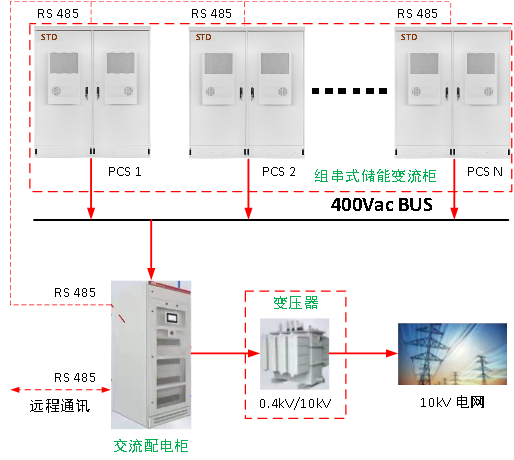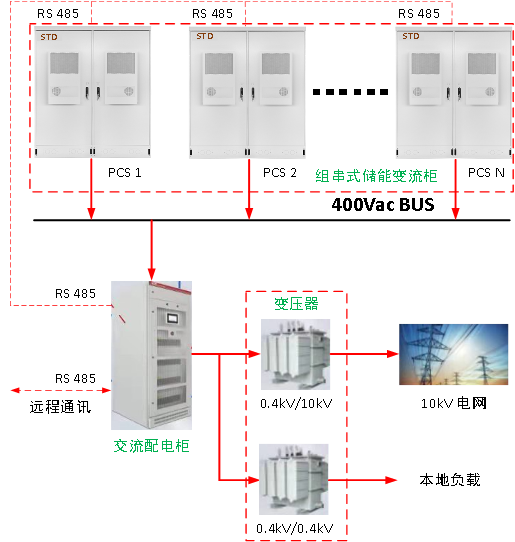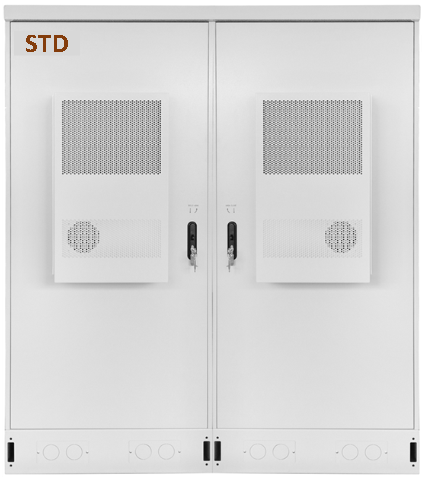1、 Product Overview
The STD series energy storage system mainly consists of a series energy storage converter cabinet, AC distribution cabinet & local EMS system, step-up transformer, etc. The functions of the series energy storage converter cabinet are mainly to achieve charging and discharging management of energy storage batteries, and to achieve energy balance management of battery PACK. The functions of the AC distribution cabinet are mainly to achieve the convergence of multiple energy storage converter cabinets after parallel connection on the AC side, The main function of the local EMS system is to manage and monitor the energy of the entire energy storage system, and to achieve information exchange with the remote backend. The STD series energy storage system adopts a battery PACK level energy balance management control and fully modular design concept, achieving higher integration, better investment, simpler operation and maintenance, and safer and more reliable value throughout the entire life cycle of the energy storage system.
2、Application Scenario
1) Application scenarios for grid side energy storage

1)Solve the instability and intermittency issues of renewable energy generation, and increase the penetration rate of renewable energy in the power grid.
2)Take advantage of the rapid and accurate response capability of battery energy storage to participate in the AGC frequency modulation auxiliary service of the power grid.
3)Utilize the flexible regulation ability of energy storage to enhance the safe and stable operation ability of AC and DC power grids.
4)Utilizing energy storage to form a buffer layer on the low-voltage side of the photovoltaic power generation system, absorbing some photovoltaic power generation with excessive output, facilitating the dispatch department to control the power flow and ensure the stable operation of the power grid.
5)By using energy storage equipment, the power generation of new energy is stored, providing a short-term smoothing function in case of fluctuations in new energy power generation.
6)During peak electricity usage periods, the use of energy storage systems for rapid discharge support effectively alleviates the pressure on transmission and distribution power plants due to concentrated load usage.
(2)User side energy storage application scenarios

1)By utilizing the difference in peak and valley electricity prices, energy storage can be achieved through charging during peak hours and discharging during peak hours to reduce user electricity costs and save electricity bills.
2)When the power grid loses power, the energy storage system operates in an off grid power supply mode to supply power to the load, reducing the economic losses caused by power grid loss.
3)By utilizing energy storage systems to replace the transformer capacity during peak power consumption, users can reduce the cost of transformer usage and reduce the investment and expansion cycle of transformers.
(3)Integrated photovoltaic energy storage application scenarios

1)The energy of photovoltaic is preferentially stored in the battery, while the remaining electricity supplies power to the load. When the photovoltaic energy is insufficient, the energy storage battery supplies power to the load.
2)When the mains power is cut off, it automatically switches to off grid load mode to ensure that the load does not lose power, and supports off grid black start to ensure emergency load power supply.
3、Appearance of series energy storage converter

The series energy storage converter cabinet integrates energy storage AC/DC module, BCU module, local EMS system, and battery system, and adopts IP54 high protection level design, which can cope with various types of outdoor weather.
4、Performance characteristics
1)Adopting a modular design concept to improve system stability, facilitate installation and maintenance, and facilitate capacity expansion.
2)It can adapt to various batteries and achieve different charging and discharging strategies for different batteries.
3)Energy scheduling can be regulated, and users can change the charging and discharging logic based on the electricity policies of different time periods in their respective regions.
4)The power factor can be adjusted arbitrarily to achieve independent control of active and reactive power, meeting different load requirements.
5)Adopting an energy balance management controller, the energy management of the energy storage system is refined to the battery PACK level.
6)Battery PACK level energy balance management controller to avoid capacity loss caused by mismatch.
7)Support the mixed use of new and old batteries, enabling phased deployment of power replenishment.
8)The series energy storage converter cabinet adopts an IP54 high protection level design, with high power density and convenient maintenance.
9)The battery pack is disposable and can be replaced directly, resulting in low operation and maintenance costs.
5、Technical parameters
|
DC side parameters |
DC voltage range |
550~850V |
|
|
Maximum DC current |
110A |
220A |
|
|
Maximum DC power |
66kW |
110kW |
|
|
AC grid connection parameters |
Rated output power |
60kW |
100kW |
|
Rated grid voltage |
400V±15% |
||
|
Grid frequency |
50Hz/60Hz±2.5Hz |
||
|
AC rated current |
86A |
143A |
|
|
Output THDi |
≤3% |
||
|
Grid connected power factor |
-1~+1 |
||
|
system parameter |
Maximum efficiency of the entire machine |
97.3% |
97.3% |
|
Wiring method |
Three phase three wire/three phase four wire |
||
|
Cooling method |
Air conditioning heat dissipation |
||
|
Noise |
70dB |
||
|
Temperature range |
-20℃~50℃ |
||
|
Protection level |
IP54 |
||
|
Altitude |
3000m |
||
|
Humidity range |
0~95% |
||
|
Dimensions (W* H * D) |
1300*1100*1850mm |
||
|
Communication method |
Display |
7-inch color touch screen |
|
|
Upper computer communication method |
ModBusTCP/IP |
||
|
Standard communication interface |
LAN、RS485、CAN |
||
|
Battery system parameters |
Battery voltage range |
500~850V |
500~850V |
|
Cell specifications |
3.2V 105AH |
3.2V 105AH |
|
|
Battery pack specifications |
51.2Vdc 10.8kWh |
51.2Vdc 10.8kWh |
|
|
Battery pack size (W * D *H) |
560*800*160mm |
560*800*160mm |
|
|
Number of battery packs |
14 |
14 |
|